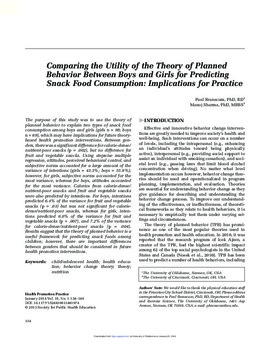| dc.contributor.author | Paul Branscum | |
| dc.contributor.author | Manoj Sharma | |
| dc.date.accessioned | 2016-01-14T19:53:42Z | |
| dc.date.accessioned | 2016-03-30T15:32:37Z | |
| dc.date.available | 2016-01-14T19:53:42Z | |
| dc.date.available | 2016-03-30T15:32:37Z | |
| dc.date.issued | 2014-01-01 | |
| dc.identifier.citation | Branscum, P., & Sharma, M. (2014). Comparing the Utility of the Theory of Planned Behavior Between Boys and Girls for Predicting Snack Food Consumption: Implications for Practice. Health Promotion Practice, 15(1), 134-140. doi: 10.1177/1524839913481974 | en_US |
| dc.identifier.uri | https://hdl.handle.net/11244/25399 | |
| dc.description.abstract | The purpose of this study was to use the theory of planned behavior to explain two types of snack food consumption among boys and girls (girls n = 98; boys n = 69), which may have implications for future theory-based health promotion interventions. Between genders, there was a significant difference for calorie-dense/nutrient-poor snacks (p = .002), but no difference for fruit and vegetable snacks. Using stepwise multiple regression, attitudes, perceived behavioral control, and subjective norms accounted for a large amount of the variance of intentions (girls = 43.3%; boys = 55.9%); however, for girls, subjective norms accounted for the most variance, whereas for boys, attitudes accounted for the most variance. Calories from calorie-dense/nutrient-poor snacks and fruit and vegetable snacks were also predicted by intentions. For boys, intentions predicted 6.4% of the variance for fruit and vegetable snacks (p = .03) but was not significant for calorie-dense/nutrient-poor snacks, whereas for girls, intentions predicted 6.0% of the variance for fruit and vegetable snacks (p = .007), and 7.2% of the variance for calorie-dense/nutrient-poor snacks (p = .004). Results suggest that the theory of planned behavior is a useful framework for predicting snack foods among children; however, there are important differences between genders that should be considered in future health promotion interventions. | en_US |
| dc.language.iso | en_US | en_US |
| dc.publisher | Health Promotion Practice | |
| dc.subject | child/adolescent health | en_US |
| dc.subject | health education | en_US |
| dc.subject | behavior change theory | en_US |
| dc.subject | theory | en_US |
| dc.subject | nutrition | en_US |
| dc.title | Comparing the Utility of the Theory of Planned Behavior Between Boys and Girls for Predicting Snack Food Consumption: Implications for Practice | en_US |
| dc.type | Research Article | en_US |
| dc.description.peerreview | Yes | en_US |
| dc.description.peerreviewnotes | https://us.sagepub.com/en-us/nam/manuscript-submission-guidelines | en_US |
| dc.identifier.doi | 10.1177/1524839913481974 | en_US |
| dc.rights.requestable | false | en_US |
